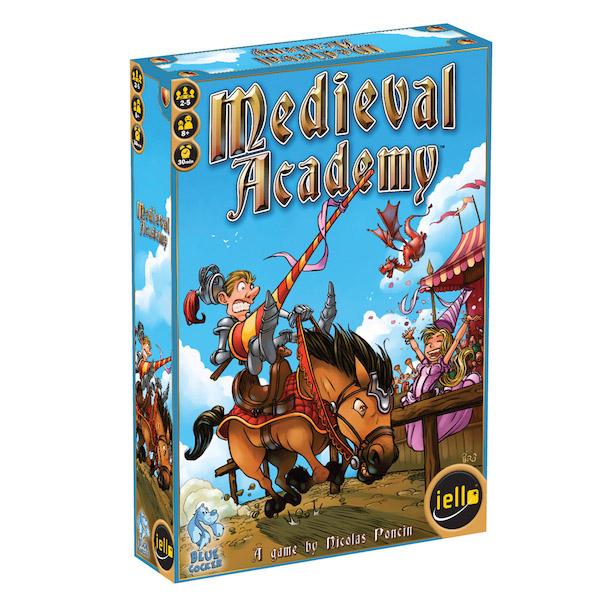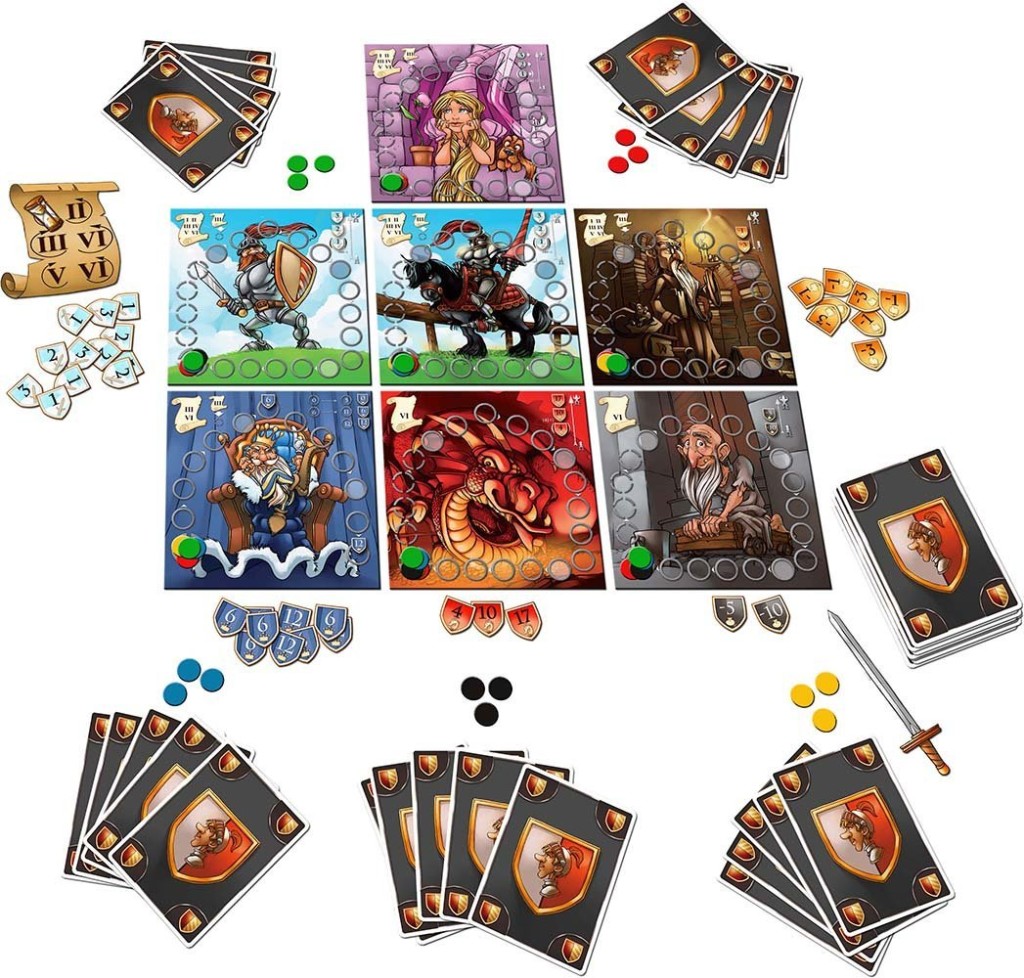If you’ve ever watched the television show “Merlin”, then you’ll know how difficult it can be to become a knight. Luckily, “Medieval Academy” is here to help you train to become one…well, sort of. You’ll have to do a number of tasks like complete quests, serve the king, and even show a sense of charity and gallantry. Only one player will be knighted, so it’s up to you to make sure you’re on top when the smoke clears.

Medieval Academy: 2-5 Players, Ages 8+, Average Play Time = 30 Minutes
Components
The game includes 7 double-sided game boards, 52 learning cards, 50 wooden discs, 1 parchment to count the turns, 1 hourglass pawn, 1 Excalibur pawn, coats of arms, and a rulebook.
And for variants: 1 bet card, 1 cup, 1 secret codex card, 2 scrolls, 1 turn order card, and additional coats of arms.
Setup & Gameplay
There are a number of ways to set up the game, as players are able to make use of both basic and advanced rules. They have the option of flipping some of the boards to their advanced side instead of all of them, if they so choose. To keep things simple, I’ll cover only the basic rule set below.
To summarize game setup, the boards are placed basic side up in the center of the table and the hourglass is put on the turn one space of the parchment. The learning cards are shuffled and the coat of arms are sorted by value off to the side. Each player chooses a color, taking the tokens of that color, and places one on each of the starting spaces on the game boards. Any extras are kept in front of them. The first person to strike the most chivalrous gets the Excalibur token and goes first.
The game is played over six turns. Each turn has six phases:
1. Deal 5 learning cards to each player.
2. Draft the learning cards – Players choose one of their cards (playing it face-down in front of them) and passes the rest in the direction shown on the parchment. The direction will change depending on which turn it is. When all cards have been drafted, the five cards in front of a player goes back into their hand.
3. Play the learning cards – Beginning with the first player and going clockwise, players play one card and move the appropriate token on one of the boards. This continues until everyone has one card remaining, which is then discarded. Players who land on another player’s token are stacked on top and are considered “ahead”.
4. Scoring – Each board is scored on different turns, as noted on the board itself. Some players make gain or lose points, depending on where they are on a particular board’s track. Players receive coat of arms tokens to track their points.
5. Reset – At the end of turn three, some of the boards are reset back to “0”, meaning all of the player tokens are moved to the beginning space again.
6. Change the first player – At the end of every turn, the next player clockwise receives the Excalibur token and becomes the first player.
At the end of the sixth turn, players count up their points (via their coat of arms) and the person with the most, wins!
Editor’s Note: The above doesn’t cover all of the rules found in the manual, but should give you an idea as to how the game is played.

The Review
Firstly, I have to give the game a big thumbs up for being so flexible in the number of ways one can play the game. There are not only basic and advanced rule sets, but you can choose which ones you want to include and which ones to omit. In addition, the game includes two different rule sets for two players. The first one adds a third dummy player which players alternate in controlling and the other adds an entirely new way to play the game.
With regards to the latter (called the “Lancelot/Real Deal” variant), both players control two colors and get six cards instead of five, separating them into piles of three face-down. Once done, they are revealed. Player A takes one of the two piles from Player B, with Player B receiving the one not chosen. Player B does the same (picking one from Player A to keep). Players then assign three cards to each of their colored tokens. When choosing one to activate later on, they resolve all three cards under that color as normal. I preferred this over the dummy player option, as I hate having to manage a third player who isn’t actually playing the game.
The components weren’t bad and the basic rules were fairly easy to understand. The advanced rule sets are a bit more complicated but not overly so. My advice is to try the advanced rule set on one board at a time so that you can get used to how it operates instead of trying them all at once. Of course, if you’re an experienced gamer and feel up to the challenge, feel free to dive in head first right out of the gate.
As confusing as it may appear to casual gamers (what with all the boards), you’re essentially just drafting cards and trying to move your tokens as far up as many tracks as you can. Each board scores during different turns, so choosing which boards to climb will give you some pause. I found this to be a fairly fun game. While it shines with three, four, and five players, the aforementioned “Lancelot/Real Deal” variant keeps things interesting when only two players are present. Not a bad buy at $25-$30, the current price on Amazon (as of 2/4/16).
Final Verdict: 7/10
